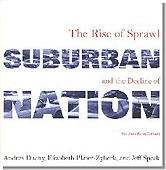Recommended Reading: Suburban Nation
The book Suburban Nation: The Rise of Sprawl and the Decline of the American Dream is the most devastating analysis I have come across of the development pattern unique to modern America. It is devastating in its straightforward analysis, its simple, yet solid, logic and its far-reaching implications.
 For anyone seeking to understand the current economic crisis, its root causes and why it is leading to the decline of America, this is your book. If you want to work to build Strong Towns, as a planner, engineer or decision-maker, this book is a must read. If you want to make sense of the world around you, this is your guide. This book will make our upcoming list of top ten essential planning books, guaranteed.
For anyone seeking to understand the current economic crisis, its root causes and why it is leading to the decline of America, this is your book. If you want to work to build Strong Towns, as a planner, engineer or decision-maker, this book is a must read. If you want to make sense of the world around you, this is your guide. This book will make our upcoming list of top ten essential planning books, guaranteed.
The book is written by Andres Duany (no stranger to readers of this blog), Elizabeth Plater-Zyberk and Jeff Speck. It systematically dissects the current pattern of development across America, which they summarize as "sprawl" but (for those who reflexively feel alienated by the term "sprawl") could also be described simply as auto-oriented.
Much of the book is an expansive version of the Duany video series we posted earlier this year during Friday News Digests. I'll link the first video again in this posting so you can give a quick listen and get hooked. Like most any book to film, the 90 minute presentation (while incredible), does not do the book justice.
The team starts out by describing sprawl, a "creature" they define as having five components:
- Housing subdivisions,
- Shopping centers,
- Office parks,
- Civic institutions, and
- Roadways.
The rest of the book contrasts the "cities" we have assembled with these components with the pre-automobile model for cities that mixed these uses, as opposed to differentiating them.
The obvious and easy example is the house one block away from the shopping center, as the crow flies. While in a traditional neighborhood housing and shopping are within easy walking distance, in the modern sprawl city this one block journey necessitates an auto trip up a cul-de-sac street, to a collector road, to an arterial road, back down the scale to the parking lot. In this model, the auto-orientation is no longer a liberating feature of life but an (expensive) necessity that leaves society with few alternative choices.
This has devastating effects for how we allocate resources, how we raise families and how we build community.
The book does not just point out flaws and draw on an idealized utopian past. It lays out some common sense policy steps that can be taken at every level of government, from the citizen activist to the federal system. Fixing this mess is possible, but it requires us to come to grips with those truths revealed through this book.
Inspiring. Invigorating. Enlightening. Empowering.
I can't say enough about it. If you want to know what you are talking about, buy and read it today.
